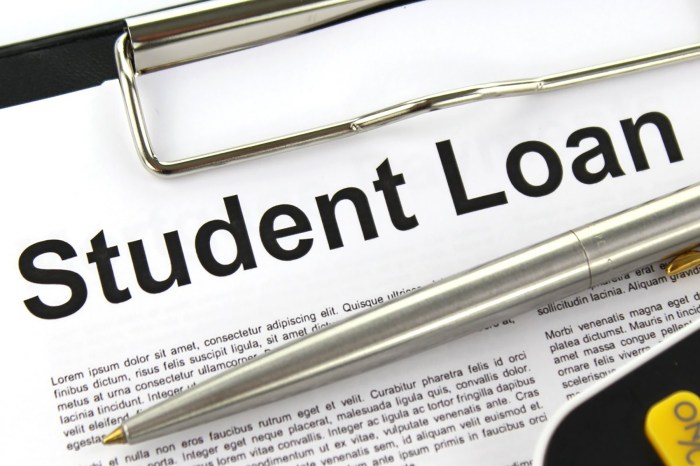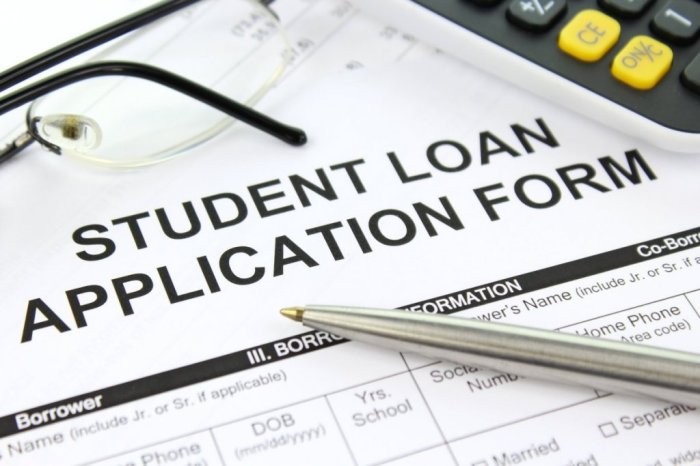
Navigating the world of student loans can feel overwhelming, but understanding the process is crucial for securing your education. This guide demystifies the application process, offering a clear path to accessing the financial support you need to achieve your academic goals. From eligibility requirements to managing repayment, we’ll cover everything you need to know to confidently apply for and manage your student loans.
We’ll explore the key differences between federal and private loans, detailing the steps involved in each application process. We’ll also provide practical advice on gathering necessary documentation, understanding loan terms, and creating a budget to effectively manage your debt. By the end, you’ll possess the knowledge and tools to make informed decisions about financing your education.
Understanding Student Loan Eligibility

Securing a student loan can significantly ease the financial burden of higher education. However, understanding the eligibility requirements and the various loan types available is crucial before applying. This section will clarify the different types of student loans, their eligibility criteria, and the necessary documentation.
Types of Student Loans
Student loans are broadly categorized into federal and private loans. Federal loans are offered by the U.S. government, while private loans are provided by banks and other financial institutions. Each type has its own set of advantages and disadvantages, impacting eligibility and repayment terms.
Federal Student Loan Eligibility
Eligibility for federal student loans primarily depends on factors like your enrollment status (at least half-time), citizenship or eligible non-citizen status, and the completion of the Free Application for Federal Student Aid (FAFSA). Specific programs, such as subsidized and unsubsidized loans, have additional requirements. For example, subsidized loans are need-based and only accrue interest while you are in school, whereas unsubsidized loans accrue interest regardless of your enrollment status. Furthermore, federal loan eligibility can also be affected by your credit history, although it is typically less stringent than private loan requirements.
Private Student Loan Eligibility
Private student loans are generally more challenging to secure. Lenders assess your creditworthiness extensively, considering your credit score, credit history, income, and debt-to-income ratio. A co-signer, often a parent or guardian with a strong credit history, is frequently required to mitigate the lender’s risk. Even with a co-signer, approval is not guaranteed and depends on the lender’s individual assessment of the applicant’s overall financial stability. Interest rates tend to be higher than federal loans, reflecting the increased risk for the lender.
Required Documentation
The specific documentation required varies depending on the lender and loan type. However, common documents include the FAFSA form (for federal loans), proof of enrollment (acceptance letter or enrollment verification), tax returns (for both federal and private loans), and sometimes bank statements. For private loans, you may also need to provide details of your income, employment history, and existing debt. It’s crucial to carefully review the specific requirements of your chosen lender before submitting your application.
Student Loan Comparison
| Loan Type | Interest Rate | Repayment Period | Eligibility Requirements |
|---|---|---|---|
| Federal Subsidized Loan | Variable; set by the government | Typically 10-20 years | FAFSA completion, enrollment at least half-time, demonstrated financial need |
| Federal Unsubsidized Loan | Variable; set by the government | Typically 10-20 years | FAFSA completion, enrollment at least half-time |
| Private Student Loan | Variable; determined by the lender based on creditworthiness | Variable; determined by the lender | Good credit score (or co-signer with good credit), proof of income, enrollment verification |
The Application Process

Applying for student loans, whether federal or private, involves several key steps. Understanding these steps will help you navigate the process efficiently and increase your chances of approval. This section details the application procedures for both federal and private student loans, highlighting crucial differences and common pitfalls to avoid.
Federal Student Loan Application (FAFSA)
The Free Application for Federal Student Aid (FAFSA) is the gateway to federal student loans. Completing the FAFSA accurately and on time is essential to securing federal financial aid. The process involves providing detailed information about your financial situation and educational goals.
- Gather Required Information: Before starting, collect your Social Security number, federal tax returns, W-2s, and bank statements. Accurate information is crucial for a smooth application.
- Create an FSA ID: You and a parent (if you are a dependent student) will need an FSA ID to access and sign your FAFSA. This is your unique username and password for the FSA website.
- Complete the FAFSA Online: The FAFSA is completed online through the official website. Carefully review each question and ensure accuracy.
- Submit the FAFSA: Once completed, submit your FAFSA. You will receive a Student Aid Report (SAR) confirming your submission and providing an overview of your eligibility.
- Review Your SAR: Check your SAR for any errors or inconsistencies. Contact the Federal Student Aid office if corrections are needed.
Private Student Loan Application
Private student loans are offered by banks and other financial institutions. Unlike federal loans, private loan applications vary significantly between lenders. However, several common steps are involved.
- Research Lenders: Compare interest rates, fees, and repayment terms from various lenders before applying.
- Pre-qualify (Optional): Some lenders allow you to pre-qualify without impacting your credit score. This gives you an idea of your potential eligibility and loan terms.
- Complete the Application: Each lender will have its own application process. Be prepared to provide personal information, academic details, and financial information.
- Provide Supporting Documents: You may need to submit supporting documents like tax returns, bank statements, or proof of enrollment.
- Review Loan Terms: Carefully review the loan terms, including interest rates, fees, and repayment options, before accepting the loan.
Common Application Errors and How to Avoid Them
Many common errors stem from inaccurate or incomplete information.
- Inaccurate Financial Information: Providing incorrect financial data on the FAFSA or private loan application can lead to delays or denial. Double-check all information before submitting.
- Missing Documents: Failing to provide required documents will delay the processing of your application. Keep all necessary documents organized and readily available.
- Incomplete Applications: Leaving sections of the application blank can result in rejection. Carefully review each section to ensure completeness.
- Incorrect Contact Information: Ensure your contact information is accurate and up-to-date to receive timely updates and communication from lenders.
- Failing to Meet Deadlines: Submit your applications well before the deadlines to avoid missing out on funding opportunities. Many scholarships and grants have strict deadlines.
Managing Your Student Loans
Successfully navigating student loan repayment requires proactive planning and diligent management. Understanding budgeting strategies, available resources, and the potential consequences of default are crucial for responsible debt management and achieving long-term financial stability.
Effective Budgeting Strategies for Student Loan Repayment
Creating a realistic budget is the cornerstone of effective student loan management. This involves carefully tracking income and expenses to identify areas where savings can be maximized and allocated towards loan repayment. Prioritizing loan payments within the budget ensures consistent progress towards debt reduction. Consider using the debt avalanche or debt snowball methods to strategize repayment. The debt avalanche method prioritizes paying off the loan with the highest interest rate first, while the debt snowball method focuses on paying off the smallest loan first for motivational purposes. Both methods can be effective, depending on individual preferences and financial situations.
Budgeting Tools and Resources
Several budgeting tools and resources can assist students in effectively managing their finances and student loan repayments. Many free budgeting apps, such as Mint or YNAB (You Need A Budget), allow users to track income, expenses, and set financial goals. These apps often provide features such as automated transaction categorization, budgeting visualizations, and progress tracking. Additionally, many universities and colleges offer free financial counseling services to students, providing personalized guidance on budgeting, debt management, and financial planning. Online resources from reputable financial institutions and government agencies also offer valuable information and tools for effective financial management.
Consequences of Defaulting on Student Loans
Defaulting on student loans has severe consequences that can significantly impact an individual’s financial future. These consequences can include damage to credit scores, wage garnishment, tax refund offset, and difficulty obtaining future loans or credit. Defaulting can make it harder to rent an apartment, buy a car, or even secure employment in certain fields. The negative impact on credit scores can persist for years, making it challenging to obtain favorable interest rates on future loans. Furthermore, the government can take legal action to recover the outstanding debt, potentially leading to significant financial hardship. For example, a defaulted student loan could result in a significant decrease in credit score, impacting future loan applications and potentially increasing interest rates. This could lead to a cycle of debt that is difficult to break.
Sample Student Loan Management Budget
The following is a sample budget illustrating effective student loan management. Remember, this is just a sample, and your individual budget will need to reflect your specific income, expenses, and loan details.
| Income | Amount |
|---|---|
| Monthly Salary/Part-time Job | $1500 |
| Scholarships/Grants | $500 |
| Total Income | $2000 |
| Expenses | Amount |
| Rent/Housing | $700 |
| Groceries | $300 |
| Transportation | $150 |
| Utilities | $100 |
| Student Loan Payment | $400 |
| Other Expenses (Entertainment, etc.) | $350 |
| Total Expenses | $2000 |
Note: This budget demonstrates a scenario where all income is allocated to expenses, including a significant portion towards student loan repayment. Adjustments should be made to reflect individual circumstances. Building an emergency fund is crucial, and should be incorporated into the budget as soon as possible.
Final Summary

Securing a student loan is a significant step towards achieving your educational aspirations. By carefully considering your eligibility, understanding the application process, and planning for repayment, you can effectively manage your student loan debt and focus on your studies. Remember, thorough preparation and proactive planning are key to a successful application and a smoother path towards financial independence after graduation. Utilize the resources and information provided in this guide to make the most informed decisions for your future.
FAQ Summary
What is the difference between federal and private student loans?
Federal loans are offered by the government and typically have more favorable terms, including lower interest rates and income-driven repayment plans. Private loans are offered by banks and other lenders and often have higher interest rates and stricter eligibility requirements.
What happens if I default on my student loans?
Defaulting on your student loans can have severe consequences, including damage to your credit score, wage garnishment, and difficulty obtaining future loans or credit.
Can I refinance my student loans?
Yes, refinancing can potentially lower your interest rate and monthly payments, but it often involves switching from a federal to a private loan, which might eliminate certain borrower protections.
How long does the student loan application process take?
The application process varies depending on the loan type and lender. Federal loan applications, like the FAFSA, can be completed relatively quickly, while private loan applications may take longer due to additional requirements and processing times.
